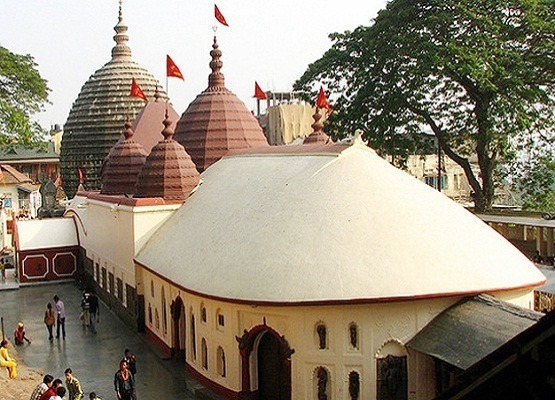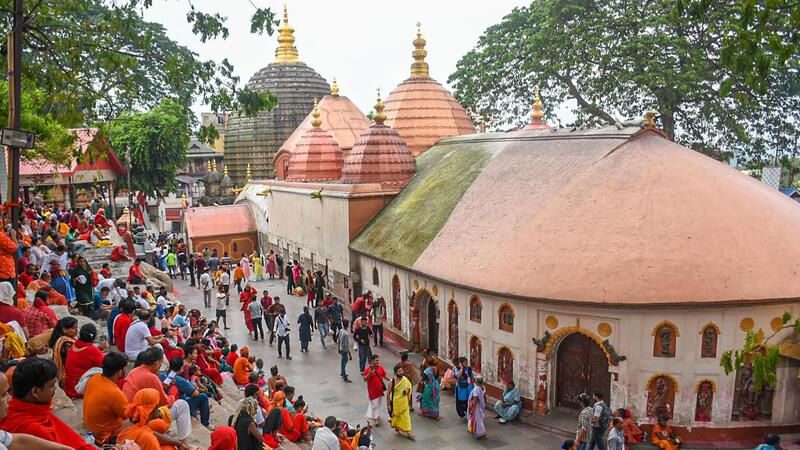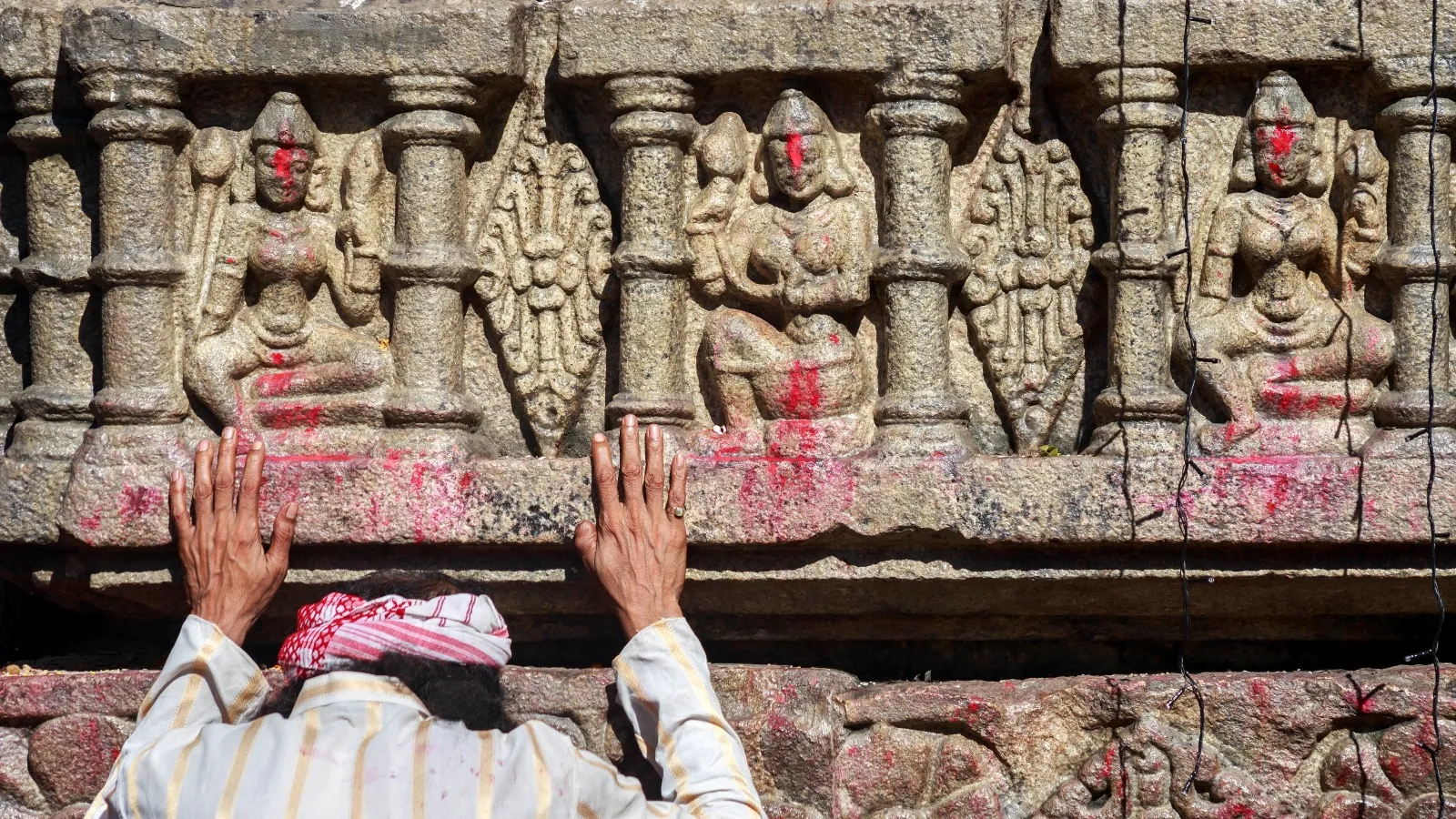
The Kamakhya Temple
The Kamakhya Temple, situated atop the Nilachal Hill in the city of Guwahati, Assam, stands as a revered sanctuary and an embodiment of divine femininity in Hinduism. Dedicated to Goddess Kamakhya, a manifestation of Adi Shakti or the primordial cosmic energy, this ancient temple carries a rich tapestry of religious significance, cultural heritage, and spiritual devotion. With roots tracing back to centuries past, the Kamakhya Temple is not merely a place of worship; it is a living testament to the enduring traditions and sacred practices associated with Hinduism. Pilgrims, seekers, and devotees from across the country converge here, drawn by the allure of tantric practices, the sanctity of the Ambubachi Mela, and the opportunity to seek blessings for fertility and well-being. The temple’s distinct rituals, festivals, and its status as one of the 51 Shakti Peethas contribute to its exceptional place in the diverse mosaic of India’s religious landscape. As we delve into the religious and cultural realms of the Kamakhya Temple, we uncover a sanctuary that transcends time, inviting individuals into a realm of spiritual devotion and divine reverence.
Namaste 🙏 नमस्ते
Secure your visit • अपनी यात्रा सुरक्षित करें
Historical background and Architectural splendor
The historical background of the Kamakhya Temple unfolds a narrative that spans centuries, reflecting the cultural evolution of the region. Its origins are deeply rooted in Hindu mythology, with the temple recognized as one of the 51 Shakti Peethas, where it is believed that the yoni (female genitalia) of the goddess Sati fell during the cosmic dance of Lord Shiva. Over time, the temple has witnessed a series of constructions, renovations, and invasions, each chapter contributing to its historical tapestry. The Ahom kings of Assam played a pivotal role in the temple’s reconstruction during the 17th century, infusing it with architectural and spiritual significance. However, the temple faced challenges during the invasion of Koch Hajo rulers and the brutal attack by Kalapahar in the 16th century, leading to damage and subsequent reconstruction. Despite such adversities, the Kamakhya Temple has endured, standing today as a testament to the resilience of faith and the enduring spirit of Hindu worship.
Architecturally, the Kamakhya Temple exemplifies a synthesis of Assamese and Hindu temple architecture. The current structure, primarily dating back to the 18th century, showcases a distinctive hemispherical dome that crowns the sanctum sanctorum, emphasizing the temple’s significance. The intricate carvings on the temple walls depict various mythological motifs and deities, adding to its aesthetic grandeur. The Kalika Purana, an ancient Hindu scripture, references the temple’s architectural details, emphasizing its sanctity and the unique blend of spiritual and artistic elements. Positioned atop the Nilachal Hill, the Kamakhya Temple commands breathtaking views of the Brahmaputra River and the surrounding landscapes, contributing to the holistic experience for pilgrims and visitors alike.

Religious Significance
This temple holds profound religious significance as a prominent seat of worship dedicated to Goddess Kamakhya, a manifestation of Adi Shakti in Hinduism. Recognized as one of the 51 Shakti Peethas, it is believed to house the yoni (female genitalia) of the goddess Sati, marking a sacred site where divine energies converge. The temple is a revered destination for devotees seeking the blessings of the divine feminine and is particularly associated with tantric practices. The Ambubachi Mela, an annual festival observed during the goddess's menstruation cycle, adds a unique dimension to the temple's religious importance, symbolizing renewal and purification. Pilgrims flock to the Kamakhya Temple to partake in rituals, seeking fertility, protection, and spiritual upliftment. Its ancient traditions, deep-rooted in Hindu mythology, contribute to the temple's significance as a sacred sanctuary where devotees connect with the cosmic energies embodied by Goddess Kamakhya.

Festival and Celebrations
Here the festivals celebrated are Ambubachi Mela, Durga Puja, Navaratri, Manasa Puja, Pohan Biya, Dol Purnima and Diwali.
Surroundings area & attractions
- Purva Tirupati Sri Balaji Mandir: Situated on the Nilachal Hill, this temple is a replica of the famous Tirupati Balaji Temple in Andhra Pradesh. Devotees can visit this temple to seek the blessings of Lord Balaji.
- Bhubaneswari Temple: Adjacent to the Kamakhya Temple, the Bhubaneswari Temple is dedicated to Goddess Bhubaneswari, a form of Devi Parvati. It is another significant shrine on Nilachal Hill.
Visitor information
Entry Fee: No fee
Morning :
- 5:30 am - Snana of Pithasthana
- 6:00 am - Nitya Puja
- 8:00 am - Temple door open for devotees
Evening :
- 1:00 PM - Temple door closed for cooked offerings for the goddess followed by distribution among the devotees
- 2:30 PM - Temple doors reopened for the devotees.
- 5:15 PM - Closing of the temple door for the night.
- 7:30 PM - Aarti of Goddess
Notable Events and Incidents
- Ambubachi Mela: An annual festival in June celebrating the goddess’s fertility, drawing thousands of pilgrims.
- Navratri & Durga Puja: The temple becomes a vibrant center of rituals and celebrations.
- Historic Incidents: The temple faced invasions in earlier centuries but was restored by the Ahom kings, preserving its spiritual heritage.
- Tantric Significance: Kamakhya has long been associated with tantric practices and rituals that add to its mystical reputation.
Connectivity:
- By Air: Lokpriya Gopinath Bordoloi International Airport is around 20 km away, with taxis and app-based cabs available to reach the temple.
- By Rail: Kamakhya Junction (7 km) and Guwahati Railway Station (8 km) provide easy access through local transport.
- By Road: Guwahati is well-connected by highways, and local buses, autos, and taxis make the temple accessible from all parts of the city.
FAQ
The Kamakhya Temple is located atop the Nilachal Hill in Guwahati, Assam, India.
The presiding deity of the Kamakhya Temple is Goddess Kamakhya, a form of the Mother Goddess or Shakti.
The Kamakhya Temple is one of the most sacred and revered Shakti Peethas (shrines dedicated to the Goddess) in Hinduism. It is believed to be a powerful center of feminine energy and fertility.
The history of the Kamakhya Temple dates back to ancient times and is shrouded in mythology. It is believed to have been originally built by the Koch dynasty rulers in the 8th-9th centuries, with subsequent renovations and additions made over the centuries.
The Kamakhya Temple exhibits a blend of architectural styles, including Assamese, Bengali, and Mughal influences. It is characterized by its unique dome-shaped shikhara (spire), sculptural embellishments, and intricate carvings depicting various deities and mythological motifs.
The Kamakhya Temple follows a strict schedule of rituals and ceremonies dedicated to Goddess Kamakhya. These include daily puja (worship), abhishekam (ritual bathing of the deity), aarti (ritual of worship with lamps), and special festivities during Navratri and Ambubachi Mela.
Ambubachi Mela is an annual festival celebrated at the Kamakhya Temple during the monsoon season. It is believed to mark the annual menstruation cycle of the Goddess Kamakhya and is considered a time of spiritual renewal and fertility.
Visitors are required to adhere to certain customs and traditions while visiting the Kamakhya Temple, including removing footwear before entering the temple complex, dressing modestly, and maintaining silence and reverence within the temple premises.
Yes, the Kamakhya Temple is open to visitors of all faiths and backgrounds. Non-Hindus are welcome to explore the temple complex and experience its spiritual and cultural significance.
Guwahati offers several other attractions for visitors, including the Assam State Museum, Umananda Temple (on Peacock Island), Assam State Zoo, and the scenic Brahmaputra River cruise.
The Kamakhya Temple is associated with several legends and myths in Hindu mythology. It is believed to be the place where the yoni (female reproductive organ) of Goddess Sati, the consort of Lord Shiva, fell after her body was dismembered by Lord Vishnu’s Sudarshana Chakra.
While the main deity of the Kamakhya Temple is Goddess Kamakhya, the complex also houses several other shrines dedicated to various deities and forms of the Goddess, including Bhuvaneshwari, Tara, Chinnamasta, Bhairavi, and Dhumavati.
The Kamakhya Yantra is a sacred geometric diagram installed within the temple premises, symbolizing the divine energy of Goddess Kamakhya. Devotees believe that meditating upon the yantra can bring spiritual empowerment and fulfillment of desires.
Devotees often perform various rituals and practices to seek the blessings of Goddess Kamakhya, including offering flowers, fruits, and sweets, chanting mantras, and participating in special pujas and homas (fire rituals) conducted by the temple priests.
The Nilachal Mahadev Temple, dedicated to Lord Shiva, is located adjacent to the Kamakhya Temple on the Nilachal Hill. It is believed to be one of the oldest temples in the region and offers panoramic views of the surrounding landscape.
The Kamakhya Temple is easily accessible by road from various parts of Guwahati city. Visitors can avail of taxis, auto-rickshaws, or buses to reach the temple complex. Additionally, there are parking facilities available for those traveling by private vehicles.
During Ambubachi Mela, devotees observe certain rituals and practices, including fasting, meditation, and offering prayers to Goddess Kamakhya. The temple authorities implement crowd management measures and provide facilities for the convenience of pilgrims attending the festival.
Photography is generally allowed within certain areas of the Kamakhya Temple complex, but there may be restrictions in certain sections or during specific rituals.
Yes, there are several accommodation options available in Guwahati city to suit various budgets, including hotels, guesthouses, and lodges. Additionally, the Assam Tourism Development Corporation (ATDC) provides accommodation facilities for pilgrims and tourists visiting the area.
The Kamakhya Temple can be visited throughout the year, but the Ambubachi Mela during the monsoon season is a particularly auspicious time to seek the blessings of Goddess Kamakhya. Additionally, Navratri and other festivals dedicated to the Goddess attract large crowds of devotees.
